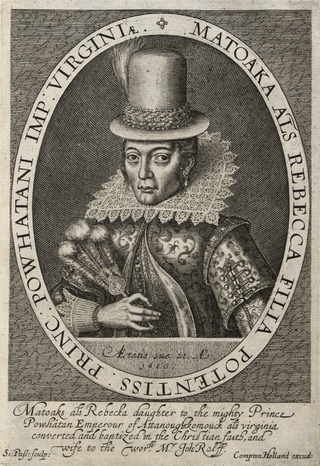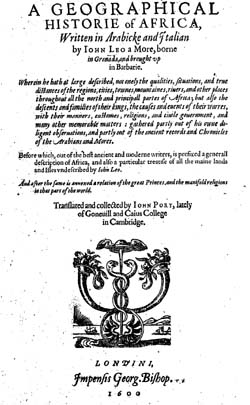
The Jamestown settlement in the Colony of Virginia was the first permanent English settlement in the Americas. It was located on the northeast bank of the James River, about 2.5 mi (4 km) southwest of the center of modern Williamsburg. It was established by the Virginia Company of London as "James Fort" on May 4, 1607 O.S., and was considered permanent after a brief abandonment in 1610. It followed several failed attempts, including the Lost Colony of Roanoke, established in 1585 on Roanoke Island, later part of North Carolina. Jamestown served as the colonial capital from 1616 until 1699. Despite the dispatch of more settlers and supplies, more than 80 percent of the colonists died in 1609–1610, mostly from starvation and disease. In mid-1610, the survivors abandoned Jamestown, though they returned after meeting a resupply convoy in the James River.

Thomas West, 3rd Baron De La Warr, was an English nobleman, for whom the bay, the river, and, consequently, a Native American people and U.S. state, all later called "Delaware", were named. A member of the House of Lords, from the death of his father in 1602 until his own death in 1618, he served as the governor of Virginia from 1610 to 1611.

John Smith was an English soldier, slave, explorer, colonial governor, admiral of New England, and author. He played an important role in the establishment of the colony at Jamestown, Virginia, the first permanent English settlement in North America, in the early 17th century. He was a leader of the Virginia Colony between September 1608 and August 1609, and he led an exploration along the rivers of Virginia and the Chesapeake Bay, during which he became the first English explorer to map the Chesapeake Bay area. Later, he explored and mapped the coast of New England. He was knighted for his services to Sigismund Báthory, Prince of Transylvania, and his friend Mózes Székely.

Pocahontas was a Native American woman belonging to the Powhatan people, notable for her association with the colonial settlement at Jamestown, Virginia. She was the daughter of Powhatan, the paramount chief of a network of tributary tribes in the Tsenacommacah, encompassing the Tidewater region of what is today the U.S. state of Virginia.

The Virginia Company was an English trading company chartered by King James I on 10 April 1606 with the objective of colonizing the eastern coast of America. The coast was named Virginia, after Elizabeth I, and it stretched from present-day Maine to the Carolinas. The company's shareholders were Londoners, and it was distinguished from the Plymouth Company, which was chartered at the same time and composed largely of gentlemen from Plymouth, England.

The coat of arms of Bermuda depicts a red lion with a shield that has a depiction of a wrecked ship upon it. The red lion is a symbol of Great Britain and alludes to Bermuda's relationship with that country. The Latin motto under the coat of arms, Quo Fata Ferunt, means "Whither the Fates Carry [Us]". The wrecked ship is the Sea Venture. The arms were formally granted by Royal Warrant on 4 October 1910, but had been in use since at least 1624. The coat of arms first appears on the cover of the 1624 edition of The Generall Historie of Virginia, New-England, and the Summer Isles. The "Somers Isles" is another name for Bermuda, named after Sir George Somers, the colony's founder.

Edward la Zouche, 11th Baron Zouche was an English diplomat. He is remembered chiefly for his lone vote against the condemnation of Mary, Queen of Scots, and for organising the stag hunt where his guest, the Archbishop of Canterbury, accidentally killed a man.

Sea Venture was a seventeenth-century English sailing ship, part of the Third Supply mission to the Jamestown Colony, that was wrecked in Bermuda in 1609. She was the 300 ton purpose-built flagship of the London Company and a highly unusual vessel for her day, given that she was the first single timbered merchantman built in England, and also the first dedicated emigration ship. Sea Venture's wreck is widely thought to have been the inspiration for William Shakespeare's 1611 play The Tempest.
The Jamestown supply missions were a series of fleets from 1607 to around 1611 that were dispatched from England by the London Company with the specific goal of initially establishing the company's presence and later specifically maintaining the English settlement of "James Fort" on present-day Jamestown Island. The supply missions also resulted in the colonization of Bermuda as a supply and way-point between the colony and England.

Anne Burras was an early English settler in Virginia and an Ancient Planter. She was the first English woman to marry in the New World, and her daughter Virginia Laydon was the first child of English colonists to be born in the Jamestown colony. Anne Burras arrived in Jamestown on September 30, 1608, on the Mary and Margaret, the ship bringing the Second Supply. She came as a 14-year-old maid to Mrs. Thomas Forrest. In November or December 1608, Anne married John Laydon/Layton/Leyden. The Laydons had four daughters, Virginia, Alice, Katherine, and Margaret. All six members of the Laydon family were listed in the muster of February 1624/5. According to the muster, Anne was 30 years of age when the muster was taken. All four children are listed as born in Virginia; their ages are not given.

John Pory (1572–1636) was an English politician, administrator, traveller and author of the Jacobean and Caroline eras; the skilled linguist may have been the first news correspondent in English-language journalism. As the first Speaker of the Virginia General Assembly, Pory established parliamentary procedures for that legislative body still in use today.

Several of the islands strung across the South entrance of Castle Harbour, Bermuda were fortified in the early days of the territory, hence the harbour's name. When official settlement of the archipelago by England began in 1612 the first permanent town, St. George's was placed on the North side of St. George's Harbour. St. George's Harbour could be accessed directly by channels from the East. Those channels, however, were shallow, suitable, originally, only for small ships. As a consequence, and despite any major settlement on its shores, Castle Harbour was an important anchorage in the early years of the colony, with its main entrance, Castle Roads being an important route in from the open Atlantic for shipping. It was also a weak point, as it was remote from the defences of St. George's Harbour, and difficult to reach. It was quickly fortified and garrisoned by a standing militia.

The State House (1620) in St. George's was the first purpose-built home of the House of Assembly, which then constituted the only chamber of the Parliament of Bermuda. Other than fortifications, it was Bermuda's first stone building. It is the oldest surviving Bermudian building, again excepting some fortifications, and has been used since 1815 as a Masonic lodge.
Henry Spelman (1595–1623) was an English adventurer, soldier, and author, the son of Erasmus Spelman and nephew to Sir Henry Spelman of Congham (1562–1641). The younger Henry Spelman was born in 1595 and left his home in Norfolk, England at age 14 to sail to Virginia Colony aboard the ship Unity, as a part of the Third Supply to the Jamestown Colony in 1609. He is remembered for being an early interpreter for the people of Jamestown as well as writing the Relation of Virginia, documenting the first permanent English colonial settlement in North America at Jamestown, Virginia, and particularly the lifestyles of the Native Americans of the Powhatan Confederacy led by Chief Powhatan.

Martin Fotherby was an English clergyman, who became Bishop of Salisbury.
The Jamestown Polish craftsmen's strike of 1619 took place in the settlement of Jamestown in the Virginia colony. It was the first documented strike in North America. Skilled craftsmen were sent by the Virginia Company to Jamestown to produce pitch, tar, and turpentine used for shipbuilding. When the colony held its first election in 1619, many settlers were not allowed to vote on the grounds that they were not of English descent, and they went on strike. Due to the importance of the skilled workers in producing valuable naval stores for the colony, company leaders bowed to labor pressure and gave full voting rights to continental workers.
Richard More was an English landowner and politician who sat in the House of Commons from 1640 to 1643. He supported the Parliamentary cause in the English Civil War.
The Cecily Jordan v. Greville Pooley dispute was the first known prosecution for breach of promise in colonial America and the first in which the defendant was a woman. This case was tried in the chambers of the Virginia Company, and never went to a civil court, for the plaintiff withdrew his complaint. The first successful case was Stretch v. Parker in 1639.

Mistress Forrest and her maid servant Anne Burras, were the first two European women to come to the Virginia Colony. Arriving on October 1, 1608, in what is known as the Second Supply aboard the English ship the Mary and Margaret under Captain Christopher Newport to resupply the colony at Jamestown, Virginia. Her husband Thomas Forrest (colonist) Esq. was listed as a gentleman on that ship as shown on its manifest, whereas she was listed only as Mistress Forrest. Thomas and Margaret had married on August 16, 1605, in St. Giles in the Fields, London, England.
Robert Beheathland,(or Behethland), born before 1587 in St Endellion, Cornwall, England, was an English gentleman who arrived in Jamestown, Virginia, in 1607 aboard one of the three founding ships, likely the Susan Constant. He is noteworthy as the only original 1607 Jamestown colonist having documented descendants living today.














